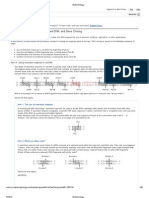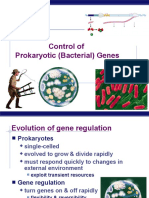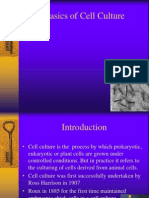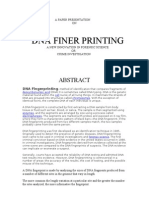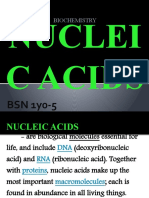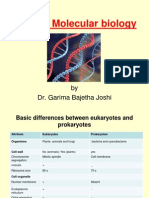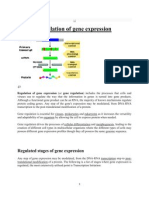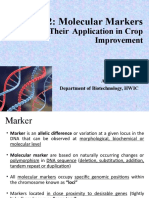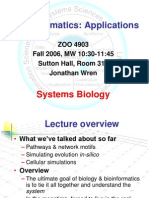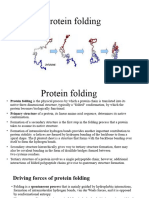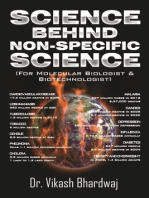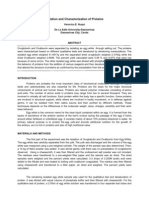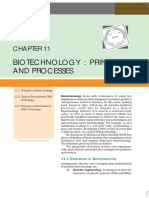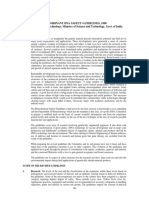Recombinant DNA
Recombinant DNA
Uploaded by
Vern NuquiCopyright:
Available Formats
Recombinant DNA
Recombinant DNA
Uploaded by
Vern NuquiOriginal Description:
Copyright
Available Formats
Share this document
Did you find this document useful?
Is this content inappropriate?
Copyright:
Available Formats
Recombinant DNA
Recombinant DNA
Uploaded by
Vern NuquiCopyright:
Available Formats
Recombinant DNA Technology and Animal Cloning
Guerrero, Victor J. Nuqui, Veronica E. De La Salle University-Dasmarinas Dasmarinas City, Cavite ABSTRACT Recombinant DNA technology has allowed individual genes to be isolated in a test tube and then characterized at the molecular level. The technology is based on restriction enzymes, which cut DNA into defined fragments. Restriction target sites can be mapped and act as DNA landmarks. Restriction fragments often have sticky ends, enabling them to be inserted into a vector capable of replicating in a bacterial cell. Such molecular hybrids are known as recombinant DNA. Bacteria amplify a single recombinant DNA molecule to form a DNA clone. Common vectors are plasmids, phages, and cosmids. An entire genome can be cloned in a set of clones known as a library. A specific clone can be found in a library by using a probe that specifically binds to the DNA or to the protein of the desired clone. Specific clones can also be isolated by their ability to transform null mutants. Through rDNA technology, several scientists have established a technique of treating several kinds of diseases by substituting the spoilt or destructive gene inside the human body with a new, fresh one. This has resulted in revolutionary discoveries in the field medicine. It has lead to the procurement of innovative technique which can help treat severe of critical diseases and create drugs, which never seemed possible before. INTRODUCTION DNA keeps all the information required to recreate an organism. All DNA have base pairs 3consisting of phosphate (Po4 ), one nitrogen base, and sugar. They consist of four nitrogen bases, namely adenine, thymine, cytosine, and guanine. These nitrogen bases are always in pairs, such as adenine with thymine and guanine with cytosine. The nitrogen bases can also be arranged in a countless ways, and their structure is well-known as the famous "double helix" which is shown in the image below. The sugar in DNA is called deoxyribose and all four nitrogen bases are the same in all organisms. The combination or arrangement of the bases is what creates diversity. DNA is not what makes the organism rather it only makes proteins. The protein synthesis starts with the DNA and from DNA to mRNA and from mRNA to protein. The process of making mRNA from DNA is called transcription and mRNA to protein is called translation. The protein forms the organism. Then DNA sequence is changed, the form of protein also changes.
Figure 1. Structure of DNA
Recombinant DNA is the general term for removing a strand of one DNA and combining it with another strand of DNA and thus the name recombinant. Recombinant DNA is sometimes referred to as "chimera. In combining two or more strands of different DNAs, scientists are now able to produce a new strand of DNA. Some geneticists prefer the alternative name chimeric DNA, after the Greek mythological monster Chimera. In some time, the Chimera has been the icon of an unfeasible biological union, an amalgamation of the different parts of an animal. Likewise, recombinant DNA wouldnt be possible without the experimental manipulation that we call as the recombinant DNA technology. Artificial clones are genetically identical and are produced by the process of somatic cell nuclear transfer (SCNT). In this procedure, the somatic cell nucleus is removed and is placed inside an enucleated egg. The egg is then implanted inside the surrogate mother and leaves it to further develop. DISCUSSION A. Making Recombinant DNA Recombinant DNA is made by joining a foreign DNA fragment into a small replicating molecule, which will then amplify that fragment along with itself and will result into a molecular clone identical to the inserted DNA. Recombinant DNA is an uncommon joining of two DNAs from different sources and can be performed on different organisms. Here are the steps in making rDNA. a. Isolating DNA The primary stem in making rDNA is to isolate two different DNAs, the Donor and the vector DNA. The procedure of isolation depends on the nature of the vector. In the case of bacterial plasmids which are common vectors, the plasmids are purified away from bacterial genomic DNA. This plasmid DNA forms a distinct band after subjecting it to an ultracentrifuge in a cesium chloride density gradient with ethidium bromide. The band is collected by hitting a hole in the centrifuge tube. In a specific alkaline pH, bacterial genomic DNA is denatured while the plasmid doesnt. Successive neutralization separates or precipitates the genomic DNA leaving the plasmid in the solution. Certain phages such as the can also be used as vectors for DNA cloning in bacterial system. Isolated phage DNA from pure suspension of is recovered from phage lysate. b. Cutting DNA Recombinant DNA was made possible after the discovery of restriction enzymes. These enzymes are naturally manufactured by bacteria as their defense mechanism against invaders including viruses. When the bacteria are attacked by viruses then it will produce restriction enzymes that act like scissors and cut or break the DNA of the viruses leaving them harmless. The enzyme act like scissors that cut the DNA of the phage making them inactivated. Importantly, restriction enzymes do not cut at random sequence of the DNA, rather, they cut at specific sequences making them suitable for DNA manipulation. Any kind of DNA molecule coming from a virus or a human contains restriction enzyme target sites that may be cut into defined size suitable for cloning. Restriction sites have no connection with the function of an organism and they would not be cut in vivo since most organisms have no restriction enzymes. EcoR1 (from E. coli) can identify the six-nucleotide-pair sequence in all organisms:
The segment above is an example of a DNA palindrome which means that both strands with the same nucleotide sequence are in anti-parallel orientation. Different kinds of restrictions enzymes recognize and cut at specific nucleotide sequence.
The staggered cut above leaves a pair sticky ends which is identical and paired. It is called sticky because they stick or bond to a complementary sequence using a hydrogen bond. The production of this sticky end is another function of restriction enzymes and making it suitable for rDNA technology. The principle is that when two different DNAs are cut using the same restriction enzyme then both will produce complementary sticky ends, making it possible for chimeras to form. Another method for cutting the DNA is with the use of mechanical shears. For example, agitation the DNA inside a blender will break the chromosome sized molecules into clonable segments. c. Joining DNA After cutting the DNA with the use of restriction enzyme it will leave a sticky end making it capable of merging or binding with a complementary DNA. The donor and vector DNAs can be mixed inside a test tube to allow their sticky ends to bind and create a recombinant DNA. The donor DNA like in the case of Drosophila is treated with EcoR1 enzyme and produced copies of fragments since double helices form between the sticky ends. There are several opened-up vector molecules contained in the solution, and different fragments of the donor DNA. As a result, a wide variety of vector carrying several donor inserts will be produced. At this time, even if the sticky ends have united to create a variety of chimeric molecules, the sugar-phosphate foundations are still incomplete at two positions in each junction. Nevertheless, the backbone or foundation can still be sealed with the use of an enzyme DNA ligase, which create phosphodiester bonds. Certain ligases can even join DNA fragments with blunt-cut edges. d. Amplifying recombinant DNA The ligated rDNA enters a bacterial cell by transformation. After it is inside the host cell, the vector can replicate because the plasmids usually have a replication origin. Now the donor DNA insert is part of the vectors length, then the donor DNA will be repeatedly replicated along with the vector. Each recombinant plasmid will enter the cell to form multiple copies of itself. Afterwards, several cycles of cell division will happen and the recombinant vector will go through a series of replication. The resulting bacterial colony will have billions of copies of the donor DNA insert.
Figure 2. Fragments of DNA from any genome inserted into vector DNA molecules
Each amplified fragment is called a DNA clone.
Figure 3. Generation of chimeric DNA plasmid containing genes
B. Cloning a Specific Gene Geneticists are interested in isolating and characterizing a particular gene of interest, therefore the procedures must be modified to isolate a specific rDNA clone that will carry a particular gene. The detail of the process is organism and gene-specific. The primary factor is the choice of a suitable vector. a. Choosing a cloning vector An ideal vector must be capable of prolific replication inside a living cell, thus enabling amplification of the inserted donor fragment. Additional requirement is to have a suitable restriction sites that can be used for inserting the DNA to be cloned. Currently there are numerous cloning vectors in use, and the choice of DNA segment relies on the size that will be cloned and on the application for the cloned gene. Plasmids: Bacterial plasmids are small circular DNA molecules. Replication of their DNA is independent of bacterial chromosome. Several types of plasmids are found in bacteria and its distribution is generally sporadic and some have plasmids and others do not. Viral Vectors: The gene or genes of concentration are merged into a genome of a virus and these viral vectors offer many advantages for cloning and for the next applications of cloned genes. Viruses efficiently infect the cells, the cloned gene can be introduced into cells at significantly higher frequency compared to simple transformation. Various types of viral vectors are specialized for making high protein level encoded by the cloned genes, as shown with the use of the insect baculovirus to express unknown proteins in a eukaryotic cell system Phage lambda: Phage is a suitable cloning vector for some reasons. First, phage heads will selectively wrap up a chromosome about 50 kb in length then this property can be used to choose an molecules with inserts of donor DNA. The core part of the phage
genome is not necessary for replication or packaging of DNA molecules inside E. coli, so the central or core part can be cut out and removed with the use of restriction enzymes and discarded. The second functional property of a phage vector is that the recombinant molecules are automatically packaged into infective phage particles and can be stored and handled experimentally. Cosmids: these vectors are phages and plasmids hybrids and can replicate their DNA inside the cell like that of a plasmid or be stored like that of a phage. However, cosmids can carry DNA inserts about three times more than that of the itself (as large as about 45 kb). Most of the phage structure was deleted, but the signal sequences that promoted the phage-head stuffing remain. This modified arrangement enables phage heads to be filled with almost all donor DNA.
b. Making a DNA library DNA library is a compilation of clones. This step is often called as shotgun cloning since the experimenter clones a vast example of fragments and anticipates that one of the clones will have the desired gene. The mission then is to find that particular clone. Types of Libraries: according to which vector is used according to the DNA source
Various cloning vectors bear dissimilar amounts of DNA, so the option of vector for library building relies on the size of the genome being prepared for the library. Plasmid and phage vectors hold small amounts of DNA; therefore these vectors are appropriate for cloning genes coming from organisms with small genomes. Cosmids can carry large quantity of DNA and other vectors such as YACs and BACs are appropriate for organisms with large genomes. Ease of handling is another significant factor in deciding for a vector. A phage library contains phages. A cosmid library is place of collection of bacteria or a set of definite bacterial cultures accumulated in culture tubes or microtiter dishes. It is necessary to decide whether to make a genomic library or a complementary DNA library. Complementary DNA is artificial DNA created from mRNA using a special enzyme called reverse transcriptase that is originally isolated from retroviruses. Using mRNA as a template, reverse transcriptase produces a single-stranded DNA molecule that can also be used as a template for doublestranded DNA synthesis. Since it is made from mRNA, the complementary DNA is a devoid of both upstream and downstream regulatory introns sequences. As a result, eukaryotic cDNA can be translated into useful protein in bacteria which is an important feature for expressing eukaryotic genes in bacterial hosts. The choice between cDNA and genomic DNA depends on the situation. If a specific gene is active in a specific tissue type in a plant or in an animal that is being sought, then that tissue will be used for the preparation of mRNA that will be converted into cDNA and then making a cDNA library from that sample. A complementary DNA library will be relatively smaller than a complete genomic library. It is because cDNA library came from the region of the genome transcribed. The complete genomic library must contain have all the genome. In some instances, the genomic fraction used in library construction can be narrowed to easily detect the desired gene. This was only possible if the researcher or a geneticist already knows what will be the target chromosome that contain the gene. One technique used in mammalian molecular genetics is to sort the chromosomes with a flow cytometer. Deferral chromosomes are passed through the the flow cytometer, which arranges the chromosomes according to size. The suitable chromosomal fraction is then utilized to create the library. Another technique possible in organisms with small chromosomes is to fractionate whole chromosomes by using pulsed field gel electrophoresis (PFGE). Electrophoresis is a universal technique
that uses gels under the influence of a strong electric field. It fractionates proteins or nucleic acids according to size. This procedure splits shorter DNA fragments. Pulsed field gel electrophoresis is a specific type of electrophoresis useful for extensive DNA molecules. It uses several swinging electric fields tilting in several different directions. These electric fields allow large DNA molecules such as whole chromosomes to twist through the gel to unusual positions according to their bulkiness. The right chromosome can be recognized on the gel by probing with a chromosome-specific probe. Then the desired chromosome can be sliced, eluted from the gel, and exploited to make a chromosome-specific library. c. Finding specific clones using probes A library might have as many as hundreds of thousands of cloned fragments and should be screened to locate the rDNA molecule that contains the gene of interest. A specific probe will find and mark the clone for the researcher to identify. Generally speaking, probes have two types: those that recognize protein and those that recognize DNA. They depend on the expected tendency of a single strand of nucleic acid to come across and hybridize to a different single strand with a paired base sequence. When a probe is denatured, it will locate and combine to other related denatured DNAs in the library. Steps in Identifying Specific Clone Transfer colonies or plaques of the library on a petri plate to an absorbent membrane by merely resting the membrane on the surface of the medium. Rind the membrane and lyse in situ the colonies or plaques clinging to the surface and the DNA denatured. Immerse the membrane with a solution of a probe that is specific for the DNA being sought. Label the probe using either fluorescent dye or a radioactivity. In general, probe is a piece of cloned DNA that has a sequence homologous to the preferred gene. The probe DNA should be made single stranded by unwinding the two halves of the double helix and afterward it will bind to the DNA of the clone being hunted. The location of a positive clone will become clear from the location of the concentrated label. d. Finding specific clones by functional complementation Specific clones in a bacterial or phage library can be distinguished through their capacity to grant a missing role on an altered line of the donor organism that acts as the transformation recipient. This procedure is called functional complementation. Here the protocol is:
The reason that this transformation process works is that the changing fragment functionally matches the deficit caused by the altered allele in the recipient. Transformants are initiated to have the vector, in most cases, hauling the wild-type allele inserted into one of the recipient's chromosomes at a place that is different from the altered locus in the recipient.
This is termed ectopic insertion. Less commonly, the transforming wild-type allele replaces the resident auxotrophic mutation by a double-crossover-like process.
C. Animal Cloning Cloning is a reproductive technology that permits livestock breeders to produce animal identical to their best animals. The genetic makeup of the animal will not be changed. The somatic cell nuclear transfer was the most popular method in cloning which many animals may be produced from a single donor. A genetic information from one animal was transferred into an empty oocyte, or egg and results in an embryo, which then implanted into a surrogate mother who carries the pregnancy to term. Clones are not genetically engineered animals for cloning does not change a DNA. It is similar to embryo transfer, vitro fertilization or artificial insemination. In the late seventies and early eighties, animal cloning has been studied since particularly the research on embryo splitting. The United States Food and Drug Administration have carried out many studies about the subject for over 30 years and covering some generations and vast families of livestock. Nuclear transfer is made by placing the donor somatic cell to an egg with removed nucleus. It is demonstrated on a culture dish with a use of an electric current. The change in electrical potential mimics the normal events of fertilization and starts the development. A key to a success of nuclear transfer is a good synchronization of the cell cycles between the egg and donor nucleus. The nucleus of the egg is inactive before fertilization. The donor cell nucleus should be made still or else, the progress will not succeed. By culturing the cell but famished it of essential nutrients, inactivation will happen. The cell ends dividing and goes through a sluggish state wellmatched with nuclear transfer. CONCLUSION Recombinant DNA technology and animal cloning were both under biotechnology in which living organism or their products were used to solve problems and make new discoveries. In Recombinant DNA technology, DNA obtained from different organisms is sliced into minute pieces and attached together to create recombinant DNA. This allows engineers to transfer the gene of one species into another in order to make a innovative genetic combination, which has proven to be very useful in the field of science, especially in agriculture and medicine. RDNA technology is very useful in finding and analyzing illnesses and treating them. This technology has even made possible the development of growth hormones, insulin and several proteins. RDNA technology can also help detect people with different cancers and correct alterations in a gene sequence. Through this technology, scientists have initiated a way of curing different types of diseases by reinstating the damaging gene in the human body with a new one. As an outcome, pioneering discoveries have known in the medical field. It directs to the acquirement of complex methods which can treat serious diseases and produce never seemed probable drugs before. There is a possibility that animal cloning can prevail over the restrictions of the typical reproduction cycle. In the prospect, it may be used to generate best herds by replicating the better animals, or to swiftly create herds of tailored animals. Valuable proteins in the milk of the transgenic farm animals were produced by the use of bioreactors.
REFERENCES (1) "An Introduction to Recombinant DNA." Rensselaer Polytechnic Institute (RPI) :: Architecture, Business, Engineering, IT, Humanities, Science. Web. Retrieved Oct. 2011 from <http://www.rpi.edu/dept/chem-eng/Biotech-Environ/Projects00/rdna/rdna.html>. (2) "Recombinant DNA Technology Problem Set." The Biology Project. Web. Retrieved Oct. 2011 from <http://www.biology.arizona.edu/molecular_bio/problem_sets/Recombinant_DNA_Technology/03t.html>. (3) Recombinant DNA Technology. . Web. Retrieved Oct. 2011 from http://www.immuneweb.com/Genetic%20Analysis/ch12.pdf (4) Retrieved Oct. 2011 from http://genome.wellcome.ac.uk/doc_WTD021034.html (5) National Academies of Science Animal Biotechnology: Science-Based Concern, 2002. Web. Retrieved Oct. 2011 from www.nap.edu/books/0309084393/html/ (6) Animal Cloning: A Draft Risk Assessment, 2003. Web. Retrieved Oct. 2011 from www.fda.gov/cvm/Documents/CLRAES.pdf
You might also like
- Restriction Enzyme Mapping Virtual LabDocument6 pagesRestriction Enzyme Mapping Virtual Labapi-522847737No ratings yet
- BiotechnologyDocument30 pagesBiotechnologyprehealthhelp71% (7)
- Recombinant VaccinesDocument22 pagesRecombinant VaccinesjugesmangangNo ratings yet
- Exploring Molecular Biology and Genetic EngineeringFrom EverandExploring Molecular Biology and Genetic EngineeringRating: 5 out of 5 stars5/5 (1)
- Restriction Enzymes MSC BiotechDocument37 pagesRestriction Enzymes MSC BiotechRoneet Ghosh0% (1)
- Molecular BiologyDocument26 pagesMolecular BiologyShadma KhanNo ratings yet
- Genetics, Lecture 11 (Lecture Notes)Document16 pagesGenetics, Lecture 11 (Lecture Notes)Ali Al-QudsiNo ratings yet
- Nucleus: Click To Edit Master Subtitle StyleDocument29 pagesNucleus: Click To Edit Master Subtitle StyleAzifah ZakariaNo ratings yet
- In-Depth Steps Towards Nucleic Acid and Protein SynthesisDocument21 pagesIn-Depth Steps Towards Nucleic Acid and Protein SynthesisGbenga AjaniNo ratings yet
- Recombinant DNA Cloning TechnologyDocument71 pagesRecombinant DNA Cloning TechnologyRajkaran Moorthy100% (1)
- Cell Biology and Membrane BiochemistryDocument106 pagesCell Biology and Membrane BiochemistryVijay Bhasker TekulapallyNo ratings yet
- Transcriptomics: Shivangi Asthana B.Sc. BiotechDocument22 pagesTranscriptomics: Shivangi Asthana B.Sc. Biotechsachin kumarNo ratings yet
- Western Blotting MicrsoftDocument45 pagesWestern Blotting MicrsoftSoNu de Bond100% (2)
- Types of Electrophoresis and Dna Fingerprinting B: 5,, ,: Y Group Lood Martos Panganiban TrangiaDocument73 pagesTypes of Electrophoresis and Dna Fingerprinting B: 5,, ,: Y Group Lood Martos Panganiban TrangiaJelsea Amarrador100% (1)
- Genetics: Revised Curriculum OFDocument44 pagesGenetics: Revised Curriculum OFAzzura Najmie Fajriyah Tamalate0% (1)
- Gene Structure and Function Regulation of Gene Expression - Part 1Document29 pagesGene Structure and Function Regulation of Gene Expression - Part 1Ana AbuladzeNo ratings yet
- Control of Prokaryotic (Bacterial) Genes: AP BiologyDocument15 pagesControl of Prokaryotic (Bacterial) Genes: AP BiologysilNo ratings yet
- Origin of Genomes - FinalDocument30 pagesOrigin of Genomes - FinalAbhi SachdevNo ratings yet
- Transgenic Animals: Their Benefits To Human Welfare: What Is A Transgenic Animal?Document7 pagesTransgenic Animals: Their Benefits To Human Welfare: What Is A Transgenic Animal?anon_939844203No ratings yet
- Structure and Function of DNA and RNADocument6 pagesStructure and Function of DNA and RNAEngr UmarNo ratings yet
- Module-1: Genomics and Proteomics NotesDocument8 pagesModule-1: Genomics and Proteomics NotesNishtha KhannaNo ratings yet
- Cell CultureDocument33 pagesCell CultureSai SridharNo ratings yet
- Biological Databases: DR Z Chikwambi BiotechnologyDocument47 pagesBiological Databases: DR Z Chikwambi BiotechnologyMutsawashe MunetsiNo ratings yet
- Animal Tissue CultureDocument23 pagesAnimal Tissue CultureHui Jun Hoe80% (5)
- Genetics 1.1 ResumeDocument102 pagesGenetics 1.1 ResumemiertschinkNo ratings yet
- Regulation of Gene Expression 2018Document34 pagesRegulation of Gene Expression 2018nikkiNo ratings yet
- Enzymes: A Protein With Catalytic Properties Due To Its Power of Specific ActivationDocument35 pagesEnzymes: A Protein With Catalytic Properties Due To Its Power of Specific ActivationAkash SinghNo ratings yet
- Genetics NotesDocument28 pagesGenetics NotesjasNo ratings yet
- 4.biotechnology - Principle and ProcessesDocument6 pages4.biotechnology - Principle and ProcessesIndrajith MjNo ratings yet
- Bacterial GeneticsDocument9 pagesBacterial GeneticsExamville.comNo ratings yet
- Regulation of Gene ExpressionDocument18 pagesRegulation of Gene ExpressionSH MannanNo ratings yet
- PlasmidDocument8 pagesPlasmidcaturro77No ratings yet
- Postranslational ModificationDocument78 pagesPostranslational ModificationnsjunnarkarNo ratings yet
- Dna Finer PrintingDocument11 pagesDna Finer PrintingmycatalystsNo ratings yet
- DNA SequencingDocument30 pagesDNA Sequencingah9426237100% (1)
- Proteomic and ProteomicsDocument6 pagesProteomic and ProteomicsNaushad AfridiNo ratings yet
- Nuclei C Acids: BSN 1y0-5Document25 pagesNuclei C Acids: BSN 1y0-5joevette_30No ratings yet
- Basics of Molecular BiologyDocument69 pagesBasics of Molecular BiologypathinfoNo ratings yet
- Chapter 2.0 Cell Signalling and Endocrine RegulationDocument93 pagesChapter 2.0 Cell Signalling and Endocrine RegulationNurarief AffendyNo ratings yet
- A Plasmid Is A Small DNA Molecule Within A Cell That Is Physically Separated From A Chromosomal DNA and Can Replicate IndependentlyDocument5 pagesA Plasmid Is A Small DNA Molecule Within A Cell That Is Physically Separated From A Chromosomal DNA and Can Replicate Independentlyyaqoob008No ratings yet
- Regulation of Gene ExpressionDocument5 pagesRegulation of Gene ExpressionHanumat SinghNo ratings yet
- Central Dogma of Molecular BiologyDocument23 pagesCentral Dogma of Molecular BiologyEros James Jamero100% (1)
- Chromatin RemodelingDocument5 pagesChromatin RemodelingRohit GargNo ratings yet
- Animal Cell Culture - Part 1Document38 pagesAnimal Cell Culture - Part 1Subhi MishraNo ratings yet
- Cel Mol LecDocument3 pagesCel Mol LecIzza LimNo ratings yet
- DNA ReplicationDocument16 pagesDNA ReplicationStephen Moore100% (1)
- Chapter 12 Molecular MarkersDocument39 pagesChapter 12 Molecular Markersrajiv pathakNo ratings yet
- Organization and Expression of Immunoglobulin GenesDocument3 pagesOrganization and Expression of Immunoglobulin GenesDavid CastilloNo ratings yet
- RNA Processing or Post Transcriptional Modifications.Document23 pagesRNA Processing or Post Transcriptional Modifications.saeed313bbtNo ratings yet
- Molecular Biology BIOL312Document273 pagesMolecular Biology BIOL312Paul GarciaNo ratings yet
- ReplicationDocument45 pagesReplicationAleena MustafaNo ratings yet
- Lecture 32 PCR & DNA ExtractionDocument25 pagesLecture 32 PCR & DNA ExtractionJenna Scheibler100% (1)
- The Concept of The GeneDocument320 pagesThe Concept of The GeneIbrahim AliNo ratings yet
- Intracellular TransportDocument66 pagesIntracellular Transportalvitakhoridatul100% (1)
- Bioinformatics: Applications: ZOO 4903 Fall 2006, MW 10:30-11:45 Sutton Hall, Room 312 Jonathan WrenDocument75 pagesBioinformatics: Applications: ZOO 4903 Fall 2006, MW 10:30-11:45 Sutton Hall, Room 312 Jonathan WrenlordniklausNo ratings yet
- Phylogenetic AnalysisDocument6 pagesPhylogenetic AnalysisSheila Mae AramanNo ratings yet
- Urea CycleDocument11 pagesUrea CycleRohit VinayNo ratings yet
- OmicsDocument6 pagesOmicskvictoNo ratings yet
- DNA Replication in ProkaryotesDocument24 pagesDNA Replication in ProkaryotesAlbert Jade Pontimayor Legaria100% (1)
- Proteins: Structure & FunctionsDocument15 pagesProteins: Structure & FunctionsAbhinav KumarNo ratings yet
- Protein FoldingDocument21 pagesProtein FoldingRONAK LASHKARINo ratings yet
- Western BlottingDocument13 pagesWestern BlottingAshfaq Fazal100% (1)
- Science behind Non-specific Science: (For Molecular Biologist & Biotechnologist)From EverandScience behind Non-specific Science: (For Molecular Biologist & Biotechnologist)No ratings yet
- A Cross-Sectional Study On Dengue FeverDocument39 pagesA Cross-Sectional Study On Dengue FeverVern NuquiNo ratings yet
- Isolation and Characterization of ProteinsDocument3 pagesIsolation and Characterization of ProteinsVern NuquiNo ratings yet
- Biological Buffer SystemDocument4 pagesBiological Buffer SystemVern NuquiNo ratings yet
- Relationship To Other Organ SystemsDocument11 pagesRelationship To Other Organ SystemsVern NuquiNo ratings yet
- BioTechnology - Dr. Nilesh BadgujarDocument53 pagesBioTechnology - Dr. Nilesh BadgujarRohan GohilNo ratings yet
- Describe The Use of Recombinant DNA Technology in The Synthesis of Human Insulin by BacteriaDocument3 pagesDescribe The Use of Recombinant DNA Technology in The Synthesis of Human Insulin by BacteriaCleo PoulosNo ratings yet
- Pharmaceutical ProductsDocument20 pagesPharmaceutical ProductsTrexi Mag-asoNo ratings yet
- Biotech History of BiotechnologyDocument24 pagesBiotech History of Biotechnologyblanciamico1No ratings yet
- Vaccine Silva 2008Document17 pagesVaccine Silva 2008A-yung TralalaNo ratings yet
- Principles and Processes in Biotechnology - PMDDocument2 pagesPrinciples and Processes in Biotechnology - PMDBEeNaNo ratings yet
- Mock Test On Biotechnology - Principles and Processes For NEETDocument12 pagesMock Test On Biotechnology - Principles and Processes For NEETanuskakundu444No ratings yet
- Bluewhite ScreeningDocument10 pagesBluewhite ScreeningNuwanshi DissanayakeNo ratings yet
- 6 Recombinant DNA TechnologyDocument18 pages6 Recombinant DNA TechnologyJuan Sebastian100% (1)
- Study Guide 12 StsDocument9 pagesStudy Guide 12 StsJovan Marie ElegadoNo ratings yet
- DNA Clonning: Done By: Enid Hii Lin Wei & Chong Hui JunDocument16 pagesDNA Clonning: Done By: Enid Hii Lin Wei & Chong Hui JunHui JunNo ratings yet
- GSTS BioDocument40 pagesGSTS BioReggie Aleeza SalgadoNo ratings yet
- M.SC BioTechDocument39 pagesM.SC BioTechDeepakNo ratings yet
- Biology: Study MaterialDocument202 pagesBiology: Study MaterialSandeep100% (1)
- Question Paper Sp 9Document5 pagesQuestion Paper Sp 9jitendarmeena921No ratings yet
- Genetic Engineering: Wvsu - Pototan CampusDocument40 pagesGenetic Engineering: Wvsu - Pototan CampusAirah UmadhayNo ratings yet
- Biology Chapter 9Document149 pagesBiology Chapter 9sharmapratiyush123No ratings yet
- Senior Earth Life Science - Q2 - M4 For PrintingDocument22 pagesSenior Earth Life Science - Q2 - M4 For PrintingDeverly ArceoNo ratings yet
- Genetics ReviewDocument80 pagesGenetics Reviewzubair sayedNo ratings yet
- Ordinance and Syllabus: M.Sc. Biomedical ScienceDocument26 pagesOrdinance and Syllabus: M.Sc. Biomedical ScienceAnujKumarVermaNo ratings yet
- Bromelain ReviewDocument31 pagesBromelain ReviewChristmas ShineNo ratings yet
- Recombinant DNA Safety Guidelines PDFDocument54 pagesRecombinant DNA Safety Guidelines PDFAnshul AgrawalNo ratings yet
- Activities in BiotechDocument5 pagesActivities in BiotechJaycee CaragNo ratings yet
- An Introduction To Genetic Engineering: Third Edition Desmond S. T. Nicholl 2008Document12 pagesAn Introduction To Genetic Engineering: Third Edition Desmond S. T. Nicholl 2008Rosi Nurbaeti PutriNo ratings yet
- St. Xavier'S College (Autonomous), Ahmedabad-9: Msc. Biotechnology (Syllabus) (Effective 2020-2023)Document34 pagesSt. Xavier'S College (Autonomous), Ahmedabad-9: Msc. Biotechnology (Syllabus) (Effective 2020-2023)Sani PatelNo ratings yet
- BIOENG - FA1-2 (Combined)Document21 pagesBIOENG - FA1-2 (Combined)Aceriel VillanuevaNo ratings yet
- Module 24Document10 pagesModule 24Jerico CastilloNo ratings yet

